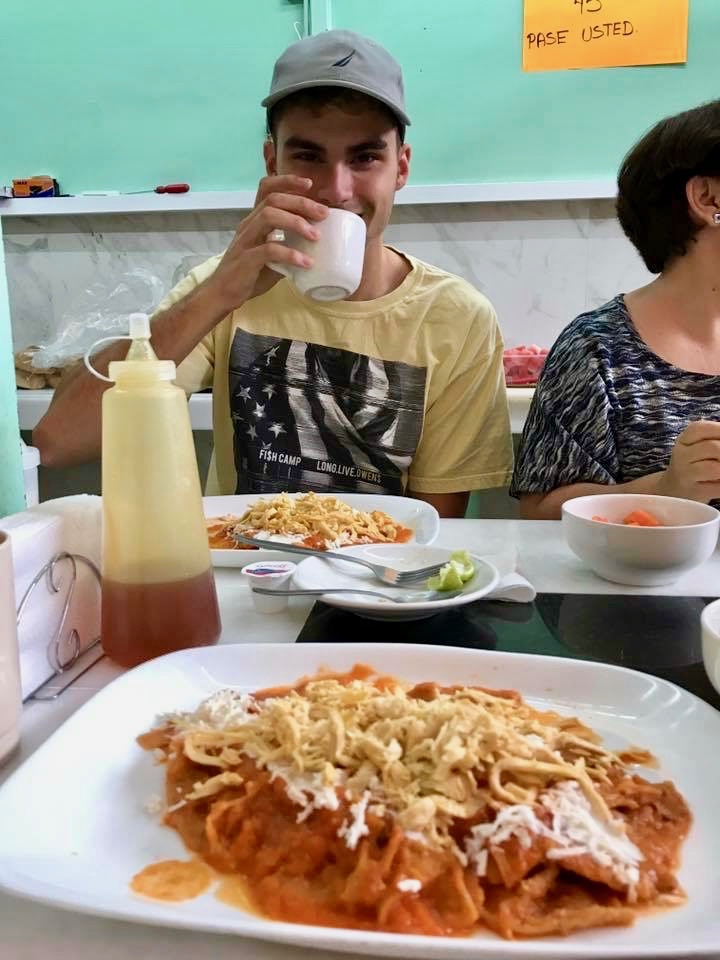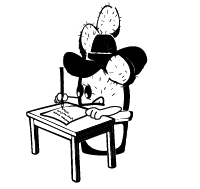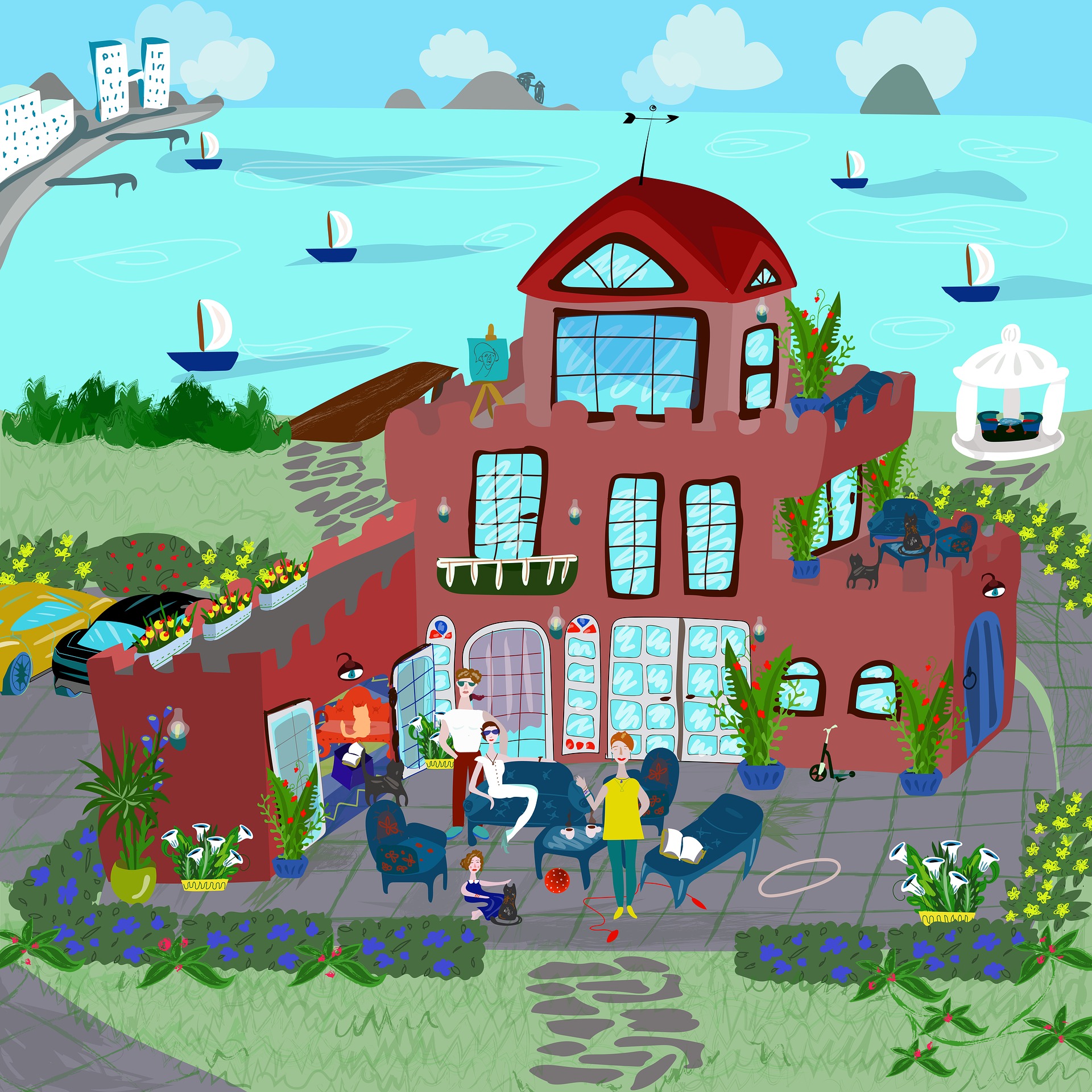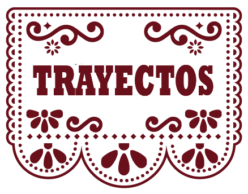Expressing Possession and Using Adjectives: Uso y forma
Let’s revisit Dylan’s blog on Mariana’s family. Read the blog once more, and focus on the way Dylan tells us that he is talking about his new Mexican family, Mariana’s family. Also look at the adjectives (those words that give us information about the characteristics of a person, place, or thing). What do you notice about the placement of adjectives and their endings?
El Blog de Dylan
Mi familia mexicana ¡La familia de Mariana es muy amable! Me siento como parte de su familia al instante. Ellos son muy divertidos y graciosos. Toman muchas fotos, como mi familia. Como ves en la foto, la familia de Mariana es enorme. Hoy vamos a comer a la casa de sus primos. La familia lejana (extended) de Mariana incluye sus tíos, abuelos, primos, sobrinos y amigos. Mariana y su familia mexicana siempre comen juntos (eat together). ¡Tenemos mucha hambre! (We’re very hungry!) Para comer, su tío cocina chilaquiles. ¡Son muy deliciosos!
I. Possession with de
In English, we express possession by using an apostrophe (’) + the letter “s” (e.g., Dylan’s blog). But what happens in Spanish? Have a look at these examples from Dylan’s blog:
- La familia de Mariana
- La familia lejana de Mariana
As you can see in these examples, in Spanish we show possession by using the preposition de + the name of the person or thing to whom/which something belongs. Also notice that there is a change in word order. In English, the person whose possessions we are talking about comes first, followed by the object he/she possesses (e.g., Dylan’s family). This is reversed in Spanish: The object comes first, and it is followed by de, and the person or thing whose possessions we are talking about (e.g., la familia de Mariana).
![]() ¡Ojo!
¡Ojo!
In the examples above we used people’s names, but if we have the article el before the person/thing whose possessions we are talking about, we must combine de and el to form del.
- El libro del [de + el] estudiante
- La computadora del profesor
Note that the articles la, las, and los are not combined with de.
- El libro de la profesora
- Las computadoras de las niñas
- La clase de los estudiantes
II. Using adjectives to express possession
In Dylan’s blog, we can also notice possession can be expressed with possessive adjectives. What are these words? Have a look at these examples:
- Mi familia mexicana
- Su tío
Yes, words like mi (my) and su (her) are possessive adjectives. We have them in English too, but in Spanish they work in a slightly different way. First, let’s have a look at them. What do you notice that is different from English?
| mi(s) | my |
| tu(s) | your |
| su(s) | his/her / your (formal) |
| nuestro/a(s) | our |
| vuestro/a(s) | your (plural; Spain) |
| su(s) | their / your (plural) |
As you can see, possessive adjectives in Spanish have plural and singular forms. This is different from English. Why is this the case? Well, in Spanish, all possessive adjectives agree in number (singular or plural) with the object being possessed (NOT with the person whose possession we are talking about). Also notice that nuestro/a(s) and vuestro/a(s) have gender, which means that their form will agree in both gender and number with the noun they’re referring to. Have a look at these examples:
- Carlos busca su libro/sus libros.
- Mis profesoras son muy amables.
- Nuestra aula es muy cómoda. vs. Nuestras aulas son muy cómodas.
- Los hijos de Carmen estudian en Tejas. Sus hijos son muy inteligentes.
- Gabriela, ¿tú hablas por teléfono con tu madre/tus padres todos los días?
III. Los adjetivos descriptivos
Now that we know what structures and words we can use to refer to possessions, let’s talk about the words we can use to describe them–los adjetivos descriptivos (descriptive adjectives). Let’s go back to Dylan’s blog. What do you notice about adjectives in these examples?
- ¡La familia de Mariana es muy amable!
- Ellos son muy divertidos y graciosos.
- La familia lejana de Mariana
- Mi familia mexicana
Yes! You guessed! Descriptive adjectives in Spanish must agree with the gender and number of the noun they describe. This is different from English. Another difference is that adjectives are usually placed after the noun they describe (e.g., la familia lejana). You already know some descriptive adjectives (remember los cognados we learned in Módulo introductorio y Módulo 1?). And here we offer you more!
![]() Describimos la apariencia física
Describimos la apariencia física
| alto | tall |
| bajo | short (height) |
| pequeño | small |
| grande | big |
| delgado/flaco | thin |
| moreno | with dark hair/dark-skinned |
| güero/ rubio | blonde or light-skinned |
![]() Describimos la personalidad
Describimos la personalidad
| abierto/a | open-minded/open |
| aburrido/a | boring |
| amable | nice |
| antipático/a | unfriendly |
| cómico/a
gracioso/a |
funny/witty |
| divertido/a | fun |
| grosero/a | rude |
| perezoso/a | lazy |
| simpático/a | friendly |
| tímido/a | shy |
| trabajador/a | hard-working |
Los cognados: These words are very similar in Spanish and English. What do they mean? Write the meaning next to the word in Spanish.
| ansioso/a |
| complicado/a |
| difícil |
| energético/a |
| extrovertido/a |
| introvertido/a |
| liberal |
| conservador/a |
| moderno/a |
| nervioso/a |
| optimista |
| pesimista |
| perfeccionista |
| sociable |
![]() El cactus viajero
El cactus viajero
- In Mexico, the word güero can be used interchangeably with rubio (blonde).
- In Argentina and Spain, the word vago is used in place of perezoso. In Mexico, flojo is preferred.
Now let’s actively use our new words, expressions, and structures. Click on ¡Manos a la obra! to continue your learning process…
 ¡Manos a la obra!
¡Manos a la obra!
Actividad 2-4. La reunión familiar de Mariana.
Mariana is writing an entry in Dylan’s blog. She is describing a road trip with her family. La familia viaja para visitar unos parientes en Oaxaca, Mexico. How is Mariana using her possessive adjectives? Complete the following paragraph with the appropriate possessive adjective.
1. ______ (My) padres, 2. ______ (my) hermanos, 3. ______ (their) gato y yo vivimos (live) en Houston, pero 4. ______ (our) parientes son de Oaxaca, México. Nosotros viajamos en el auto de 5. ______ (my) padre desde Houston a Oaxaca. 6. ______ (His) auto es muy viejo y entonces (so) 7. ______ (our) viaje dura cinco días! Primero, pasamos la frontera (border). Después, viajamos a San Luis Potosí. Allí está la casa de 8. ______ (my) tíos, Carla y Fernando. 9. ¡______ (Their) perros ladran (bark) mucho! Finalmente, llegamos a Oaxaca y pasamos mucho tiempo con 10. ______ (our) abuela y otros parientes. ¿Tú visitas a 11. ______ (your) familia seguido (often)? ¿De dónde son 12. ______ (your) padres? Deja (leave) un comentario.
![]() Actividad 2-5. Una familia.
Actividad 2-5. Una familia.
Paso 1. Con un@ compañer@, mira la ilustración y habla sobre las posesiones: ¿De quién son las cosas en la lista? Follow the model and use your creativity. Take turns asking and answering questions.
E1: ¿De quién son los barcos (the boats)?
E2: Son de los turistas.

- La casa
- Las plantas
- El libro
- Los gatos
- Los autos
- La soga de saltar (jump rope)
Paso 2. ¿Quién es esta familia?
Ahora con tu compañer@, describe a la familia en la ilustración. Use the following questions to come up with ideas. Remember that you can ask your instructor for help if you want to use a word you haven’t learned yet! And, of course, there’s always Google! Be creative!
- ¿Quiénes son los miembros de esta familia? ¿Cómo se llaman? ¿Cuántos años tienen?
- ¿Qué son (profesión)?
- ¿Cómo son los miembros de esta familia? Usando las palabras en Hablemos de gramática: Estructura 1, describe la apariencia física y la personalidad de cada (each) miembro de esta familia.
- ¿De dónde son?
- ¿Dónde están ahora (now)? ¿De quién es la casa? ¿Dónde está la casa? ¿Cómo es la casa?
![]() ¡Ojo!
¡Ojo!
Nota. In Módulo introductorio, we introduced the question ¿Cuántos años tienes? to ask about someone’s age. You can learn the forms of the verb tener to talk about people’s age. The forms are presented below. Also, pay attention to the example.
(Yo) tengo veinte años.
Formas: Tú tienes/vos tenés; él/ella/usted tiene; nosotros/nosotras tenemos; vosotros/vosotras tenéis; ellos/ellas/ustedes tienen.
Paso 3. Now use the ideas you guys discussed, and write a short composition describing the family in the painting. Be prepared to share your work with your other classmates.
![]() Actividad 2-6. Una entrevista a Cintia.
Actividad 2-6. Una entrevista a Cintia.
Cintia is the president of the Mexican Student Association at a university in Texas. In the following interview, she talks about her family from the state of Guanajuato, Mexico. Remember the city of San Miguel de Allende? We learned about it in Módulo 1. San Miguel de Allende is in Guanajuato. Ahora mira el video y contesta las siguientes preguntas.
Attribution: By Marlenie Arzamendi and Dylan Manshack, licensed under CC BY-SA 4.0.
-
-
- ¿A qué hora es la entrevista?
- ¿De dónde es Cintia?
- ¿Qué ciudad de Tejas es la ciudad de Cintia?
- ¿Cuántos años tiene Cintia? ¿Cómo es? (Describe a Cintia usando las imágenes.)
- ¿Quién es el ídolo de Cintia? ¿Cómo es esta persona?
- ¿De qué otros parientes habla Cintia? ¿Cómo son?
- ¿Es Cintia hija única?
-
![]() ¡Conversemos!
¡Conversemos!
Today in your Spanish class you are learning about families. Your Spanish professor asks you to work with a classmate to find out about each other’s family. Talk about the members of your immediate family and your relatives. Talk about their personality and physical appearance and age (remember to use the verb tener; see Actividad 2-5); where they are from; what they do for a living. Also give information about their routines (e.g., activities during the week and weekend, etc.). Use the vocabulary and structures we learned in Módulo introductorio y Módulo 1.
Click on the following button to practice your new vocabulary and structures.
Now it’s time to learn more culture! Let’s move to


